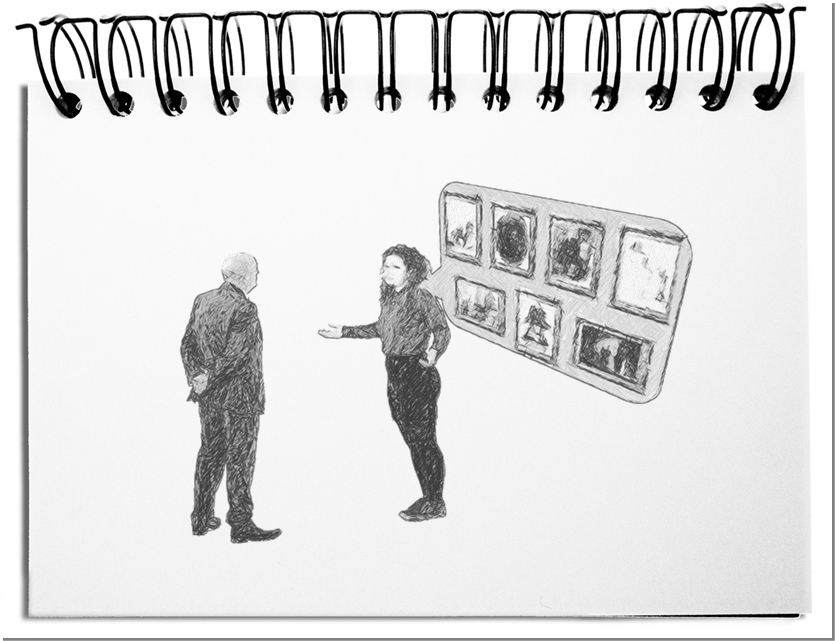We are stuck in the dilemma of being exposed to an increasing flood of data at shorter and shorter intervals. There is not enough time to process it adequately. In addition, culturally conditioned means of expression burden the exchange. When high-context meets low-context, the unfamiliar style of the counterpart triggers unexpected reflexes: Boredom or impatience, lack of and misunderstanding, and, in the end, differently construed outcomes. If signs, words, and expressions are interpreted differently, this puts a strain on mutual understanding. This pressure is especially true if the content is not conveyed with sense(ly) images.
The contents become symbolic by not limiting themselves to numbers, data, and facts, but by additionally describing sensual aspects: visually, auditorily, kinesthetically. For this purpose, we express an issue through multiple channels. Vehicles for this are metaphors, analogies, or symbols, which we describe in writing or pictorially.
- Symbol – the minimalist meaning carrier
A symbol is a simple sign that represents complex facts. In South Africa’s Blombos Cave is the oldest symbol found to date (estimated to be 75,000 to 100,000 years old) – a type of cross-hatching (more about such discoveries: here). Currently, anthropologists believe that it is magical good luck mojo for hunting. Experienced shamans, immersed in a trance, painted them on the walls of uninhabited caves. Nowadays, we know symbols in different areas. In politics, we are familiar with national flags, crests, and party logos. The followers of a religion draw a lot of strength and community spirit from their signet. This is true for the Christian cross, the Muslim crescent moon, or the Jewish Star of David. In PR, we find precious logos, such as the Olympic circles, the Audi circles, or Apple’s apple. Technicians use graphical symbols to represent complex relationships in their blueprints, process descriptions, and structural diagrams.
A symbol is an emblem and a sign of recognition. It refers to the extensive facts of a subject area. On the one hand, a sign warns against the undesirable or the rejected. It deters and alerts with a warning against deer crossing or with a skull against a poisonous substance. On the other hand, a symbol creates a sense of community and thus an identity. - Analogy – by virtue of the same properties
An analogy occurs when two circumstances or things have the same characteristics. In the simple case, it is a matter of similar attributes. An example is the comparison of Xi Jinping with Mao Zedong (both are paramount leaders of China). Complex cases arise from similar, indirectly derived features. The clockwork and the tayloristic company structure have some things in common. Take as an example the property that they are made up of parts that together serve a purpose and are comparably vulnerable.
The analogy thrives on the fact that we recognize similar patterns in different circumstances by which we notice the same characteristics. It does not matter whether or how we evaluate the overlapping features. Wooden and plastic bricks have the same properties. They can be combined in any way and reused infinitely. In addition, they train fine motor skills, create a sense of creative achievement, and can be applied regardless of age. - Metaphor – the thrilling analogy
Metaphors describe sophisticated analogies with additional aspects, adapted structures, a purposeful storyline, and convincing arguments. If we look at the construction of an edifice, it resembles a project. Both consist of various tasks, roles, interdependencies, sequences (with a defined start and end), milestones, and much more. When building the pyramids, we think of huge building elements, „slaves“, resources, transport routes and techniques, rooms, rituals, and much more.
The metaphor thrives on an exciting story. It sweeps the audience along with the help of a sophisticated arc of suspense, and effectively conveys the actual message. When, for instance, building blocks create unexpected structure like a bridge that carries three people and spans a three-meter-wide stream. And more than 500 people build the whole in 60 minutes. The story conveys that we can achieve the seemingly unthinkable if we try. The astounding conclusions have a lasting effect on the audience, reaching them emotionally and anchoring them in their minds.
Bottom line: The desire to present content or oneself in the best possible way leads to supposedly complete content overloaded with data. Prosaic presentations are difficult to process and remember because they are free of emotional anchors. Using a sensually charged metaphor increases the likelihood that the audience will pick up the desired core messages. At its simplest, signs create a curious symbol that reminds people of the topic when it appears. A sensually charged metaphor makes it more likely that the audience will take away the untended core messages. A metaphor has a lasting effect if it presents the features and components in an exciting way. The coherent flow ends up justifying the theme presented. The sense(ly) image provides the energy that permeates all participants and their activities and preserves the momentum.


